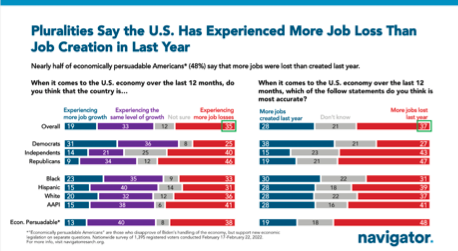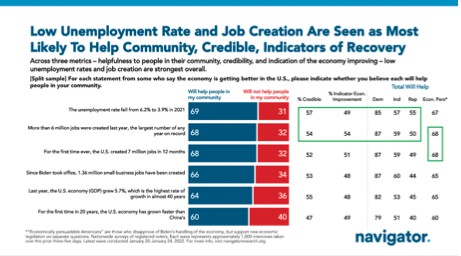WASHINGTON, D.C. — Today, ahead of President Biden’s State of the Union address, in which he is expected to address Americans’ growing economic concerns, Navigator Research released new polling revealing a gap between official metrics of economic health and how people are experiencing the economy.
Fewer than one in five Americans believe the economy is experiencing more job growth than usual, despite the fact that the U.S. added more than 6 million jobs to the labor market last year — the biggest one-year gain for job creation in United States history.
“There is a vast disconnect between what Americans think about job growth and how the labor market grew in 2021, which has significant implications for their overall economic perceptions,” said Bryan Bennett, the Senior Director of Polling and Analytics at the Hub Project and an advisor to Navigator. “Americans see job growth as a telling and credible indicator of the nation’s economic health, and President Biden has an opportunity to lay out some of these economic successes in his State of the Union address to help bridge this enormous divide between perception versus reality.”
The new polling also found just 19 percent of respondents believe that the U.S. economy is experiencing more job growth than usual, including only 31 percent of Democrats, 14 percent of Independents, and 9 percent of Republicans. Americans are more likely to believe that the economy is experiencing a similar level of growth compared to prior years (33 percent) or even more job losses than compared to prior years (35 percent). This polling comes after the January jobs report found that nearly half a million jobs were added to the labor market in the first month of 2022, and ahead of the release of the February report, which is expected on Friday.

This disconnect around job growth may be contributing to continued negative sentiment about the state of the U.S. economy overall: only 26 percent rate the U.S. economy positively while 71 percent are more negative, with most Americans saying they believe the economy is getting worse (55 percent). Nearly four in five Americans believe the costs of everyday goods like groceries are going up a significant amount (78 percent), and a similar share — 77 percent — believe the price of gas is going up a lot, a high in recent Navigator’s tracking.
When Americans do hear about job creation and economic growth, however, they find those benchmarks to be credible indicators of economic health. Statements such as “last year, the U.S. economy (GDP) grew 5.7%, which is the highest rate of growth in almost 40 years” and “more than 6 million jobs were created last year, the largest number of any year on record” were considered good indicators of a recovering economy by most Americans (54 percent and 51 percent, respectively).

###
About Navigator Research
The Navigator Research project is designed to act as a consistent, flexible, responsive tool to inform policy debates. By conducting research and providing reliable guidance to inform allies, elected leaders, and the press, Navigator helps top leaders in Washington and grassroots leaders around the country shape the debate on the issues that matter most. Follow us on Twitter for the latest updates.
About the Study
Global Strategy Group conducted public opinion surveys among a sample of 1,395 registered voters from February 17-February 22, 2022. 100 additional interviews were conducted among Hispanic voters. 75 additional interviews were conducted among Asian American and Pacific Islander voters. 100 additional interviews were conducted among African American voters. 100 additional interviews were conducted among independent voters. The survey was conducted online, recruiting respondents from an opt-in online panel vendor. Respondents were verified against a voter file and special care was taken to ensure the demographic composition of our sample matched that of the national registered voter population across a variety of demographic variables. The margin of error at the 95 percent confidence level is +/- 3.1 percent.